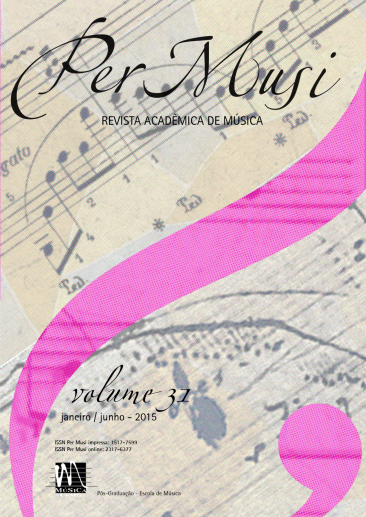Gesto na performance da percussão, Parte 1
análise percentual de dados experimentais
Palavras-chave:
Influência do gesto na performance, Percussão, Performance, Estatística descritivaResumo
Este artigo, Parte 1 do mesmo estudo, mostra como foi realizado um tratamento descritivo, através de uma análise percentual, dos dados experimentais obtidos ao observar a influência do gesto corporal sobre as sensações de continuidade, suspensão e conclusão de um trecho musical em percussão. Dentro da complexa relação estabelecida entre o percussionista e o texto musical apresentado em grande parte das produções para percussão, procuramos compreender até que ponto o corpo poderá ser um agente auxiliador no processo de transmissão de sensações específicas sobre a música executada em uma performance percussiva. A complexidade deste processo experimental nos obrigou a dividir os resultados obtidos em dois artigos. Este trabalho trata-se da 1ª parte de publicação dos dados adquiridos e analisados a partir dos pesos percentuais.
Referências
BOUENARD, A., M. WANDERLEY e S. GIBET (2011). “Analysis of Timpani Preparatory Gesture Parameterization”. McGill University 2009 [consultado a 26/10 2011]. Disponível em http://hal.archives-ouvertes.fr/hal-00369241/en/.
BERNARD-MÂCHE, F. (1982). Phènix. Paris: Editions Durand.
CHAIB, F. (2012). O Gesto na Performance em percussão: Uma abordagem Sensorial e Performativa. Tese de Doutorado. Departamento de Comunicação e Arte da Universidade de Aveiro.
________. (2012) “Três Perspectivas Gestuais para uma Performance Percussiva: Técnica, Interpretativa e Expressiva”. Per Musi, Belo Horizonte, n-27. p.159-181.
DAHL, S. (2000). “The Playing of an Accent – Preliminary Observations from Temporal and Kinematic Analysis of Percussionists”. Journal of New Music Research n.29 vol.3: 225-233.
________ (2004). “Playing the Accent – Comparing Striking Velocity and Timing in an Ostinato Rhythm Performed by Four Drummers”. Acta Acustica n.90: 762-776
_________ (2005). On the beat: Human movement and timing in the production and perception of music. PhD Thesis, KTH Computer Science and Communication, KTH School of Computer Science and Communication, Stockholm.
GODØY, R. (2011) “Co-articulated Gestural-sonic Objects in Music”. In. New Perspectives in Music and Gesture. SEMPRE. MPG Books Group. UK.
GODØY, R., e M. LEMAN. (2010). Musical Gestures - Sound, Movement, and Meaning. New York: Routledge.
LERDHAL, F., e R. JACKENDO. (1983). A Generative Theory of Tonal Music. Massachusetts: The Massachusetts Institute of Technology.
McGurk, H. e MacDonald, J. W. (1976) “Hearing lips and seeing voices”. Nature, 264:7 46–748.
PENNA, A.G 2000. Introdução ao Gestaltismo. Coleção Introdução à Psicologia. Rio de Janeiro: Imago.
SCHUTZ, M. e S. LIPSCOMB. (2004). “Influence of Visual Information On Auditory Perception Of Marimba Stroke Types.” ANAIS do VIII International Conference of Music Perception and Cognition (ICMPC8), s/p. Evanston.
________________________. 2007. “Hearing gestures, seeing music: Vision influences perceived tone duration”. Perception n.36: 888-897.
SALDAÑA, H. M. e ROSENBAUM, L. D. (1993). “Visual influences on auditory pluck and bow judgments”. Perception & Psychophysics, 54(3): 406–416.
SMITH, S. A. (1941) Suite for Drums. New York: Fillmore Music House.
WANDERLEY, M., B. VINES, N. MIDDLETON, C. MACKAY, e W. HATCH. (2005). “The Musical Significance of Clarinetists' Ancillary Gestures: An Exploration of the Field”. Journal of New Music Research n.34: 97-113.
YOST, W. A. (2000). Fundamentals of Hearing. 5a ed. Maryland Heights: Academic Press, Elsevier.
Downloads
Publicado
Edição
Seção
Licença
Copyright (c) 2015 Per Musi

Este trabalho está licenciado sob uma licença Creative Commons Attribution 4.0 International License.

Exceto onde está indicado, o conteúdo neste site está sob uma Licença Creative Commons - Atribuição 4.0 Internacional.












